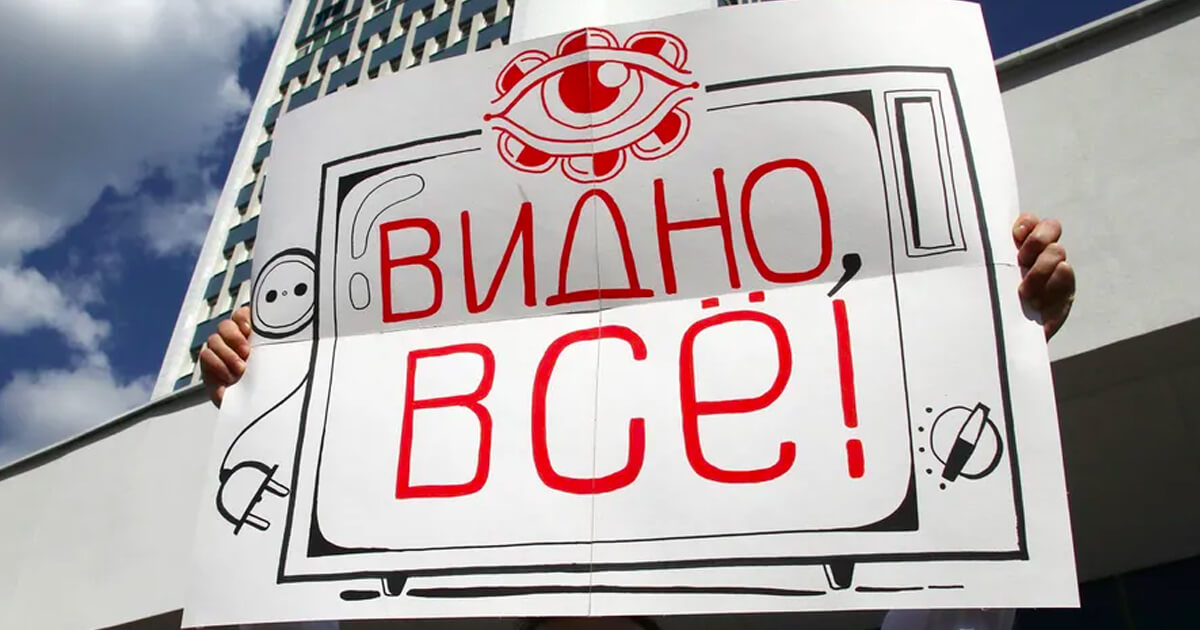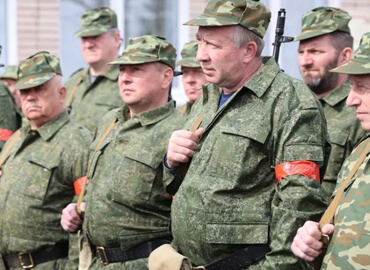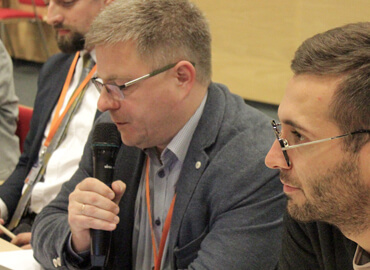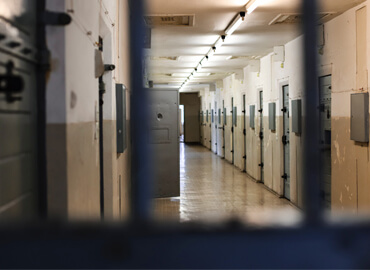
Workers on strike outside Belteleradio’s headquarters in Minsk on August 17, 2020. Sign reads: “Always watching!”
Valery Sharifulin / TASS / Scanpix / LETA
Last month, after workers at state television and radio broadcasters in Belarus started walking off the job in protest as the police brutally dispersed opposition demonstrations, a handful of independent journalists and activists reported that whole brigades of “strikebreakers” from Russia arrived to replace these employees. President Alexander Lukashenko himself fueled these rumors by repeatedly thanking Russian journalists for their help and support. There is in fact a large group of reporters from Russia’s state and pro-Kremlin media (primarily from Russia Today) now in Belarus. Russian workers are unlikely to replace the Belarusian staff now on strike, but their assistance to the local state broadcasters is nevertheless observable in the dramatically changed rhetoric now coming from Minsk. Together with the Belarusian projects Reform.by and iSANS, Meduza investigative editor Alexey Kovalev analyzes the Belarusian media’s aggressive turn and asks who facilitated it.
How the Russian media covers the protests in Belarus
From the very start of mass protests against fraud in the Belarusian presidential election, the pro-Kremlin and Russian state media’s coverage hasn’t been entirely uniform (or at least it wasn’t at first). In mid-August 2020, sources at major state media outlets in Russia told Meduza that they’d yet to receive specific instructions about how to report on the demonstrations and whether they should support Alexander Lukashenko.
In early September, the differences in Belarus coverage by various Russian news outlets were unmistakable. For example, one of the largest Russian state news agencies — TASS — strived from the beginning for objectivity, publishing crowd-size numbers from the police and protesters alike (reporting not just the authorities’ obvious underestimates). TASS also informed its readers about violence against demonstrators and even quoted Belarusian opposition leaders and some of the ordinary people who attended rallies against election fraud.
Russia Today has taken a dramatically different approach in Belarus. For example, when RT and TASS covered the exact same protest in the capital’s Independence Square, Russia Today correspondent Konstantin Pridybailo said, “There are roughly 20,000 in central Minsk now… Far fewer than there were a week ago.” The Belarusian Interior Ministry reported the same numbers. In its headline about the demonstration, however, TASS immediately questioned the authorities’ arithmetic, treating it as a “claim” and not a fact.
Even media outlets managed by the same editor-in-chief — Margarita Simonyan — have handled Belarus differently. For instance, Russia Today hosted a guest who warned that European Union flags spotted at protests in Minsk were “a signal from over there” to rally the Belarusian opposition around an anti-Russia agenda. Meanwhile, at RIA Novosti (which belongs to a media conglomerate Simonyan also oversees), a correspondent reported that Belarusian demonstrators demanded the removal of the EU flag, calling it a trick and a “provocation.”
After numerous TV anchors and technical staff at Belarusian state media outlets either quit or went on strike (refusing the government’s instructions to defend Lukashenko when covering protests), opposition websites reported that “strikebreakers” from Moscow — specifically from Russia Today — started replacing the outgoing journalists. To support this theory, activists cited suspicious spellings in chyrons on the state television network ONT (where “Belarus” suddenly became “Belorussia”), as well as a wave of reposts of RT content by pro-government Belarusian Telegram channels.
For some, the smoking gun seemed to be Alexander Lukashenko himself, who time and again thanked Russian journalists, their managers, and even Russia’s ambassador in Belarus for their assistance in the information sphere.
“You understand how important you were to us in this difficult period. And what you’ve shown us technically, your techies, journalists, and correspondents, and so on… And your director [Margarita Simonyan]. It means a lot,” Lukashenko told Konstantin Pridybailo on September 1, brushing aside the correspondent’s assertions that Russia Today isn’t replacing anyone.
Journalists, however, have failed to dig up conclusive proof that Russians replaced the Belarusian journalists who walked off the job. Sources at Belteleradio told Meduza that the number of resignations and employees going on strike never reached the critical mass that would have required an immediate influx of Russian specialists.
Moscow’s landing party in Minsk
A large group of journalists from Russia’s state media and pro-Kremlin news outlets is nevertheless working now on the ground in Minsk. These reporters, moreover, are virtually all that’s left of the international press in Belarus. (Most other Russian and foreign correspondents have either left Belarus willingly or were deported after losing their media accreditation.)
Russia Today unquestionably has the biggest contingent still in Belarus. For example, Meduza learned about at least a dozen RT staff — correspondents, camera operators, producers, and department heads — now staying at just one hotel in Minsk (see below). Some of these people were working in Belarus before the presidential elections ended on August 9, while others arrived a week later, at the height of the opposition’s protests. Another third showed up in early September to prepare for a major interview with Alexander Lukashenko, which Margarita Simonyan joined.

Posing with Alexander Lukashenko following a joint interview in Minsk on September 9, 2020. From left to right: “Pervyi Kanal” anchor Anton Vernitsky, Russian Ambassador to Belarus Dmitry Mezentsev, Belarusian President Alexander Lukashenko, “Russia Today” and “Rossiya Segodnya” editor-in-chief Margarita Simonyan, “Rossiya 1” anchor Evgeny Rozhkov, and “Govorit Moskva” editor-in-chief Roman Babayan.
BelTA / TASS / Scanpix / LETA
When we sent questions to Russia Today about its operations in Belarus, the network shared its responses publicly on its Telegram channel before Meduza published this story (pro-Kremlin media outlets and press services in Russia are fond of preempting news reports in this fashion). Based on the information posted to Telegram, RT and Ruptly (a division of Russia Today that sells video content to other media outlets, including Meduza) now employ 32 people in Belarus.
The Minsk hotel now housing all those Russia Today workers has also opened its doors to other Russian journalists — staff from NTV, the All-Russia State Television and Radio Broadcasting Company, and the Russian Defense Ministry’s Zvezda network, for example — all doing their part to support the Belarusian authorities.
NTV sent Konstantin Yarovenko, a former cameraman with the Moscow police department who took a broadcasting job with the network in 2008 and helped assemble damaging “documentary films” about the Russian opposition that even instigated criminal prosecutions against some activists. Ironically, Yarovenko was part of the same team at NTV that created a five-part television series called “The Godfather” that harshly criticized the Lukashenko regime. (The show aired a decade ago when an energy dispute upset the Moscow-Minsk partnership and Lukashenko briefly sought rapprochement with the West.)
NTV’s “The Godfather” so enraged and frightened the Belarusian president that his government censored both the TV series itself and any mention of it in the independent media. In 2020, however, the Russian network finds itself decidedly in Lukashenko’s camp, whether it’s selecting studio guests for its political talk shows or scripting “jokes” for its satirical program “Mezhdunarodnaya Pilorama” (International Sawmill), hosted by Tigran Keosayan, Simonyan’s husband. On September 5, Keosayan’s show featured a staged interview with an actress lampooning Belarusian protesters. In a traditional national dress with the opposition’s white-red-white Belarusian flag painted on her cheek, the woman complained that the West paid her too little money to attend the rally, said she’d really only come to flirt with the handsome riot police officers, and then revealed that she was in fact there to protest against “small tits.” (After the broadcast, the actress who played this role — Ekaterina Shmakova — shared a video on her Facebook page where she apologized, in tears, “to the women of Belarus” for the insulting sketch.)
Sources told Meduza that staff from state and pro-Kremlin media outlets in Russia have traveled to Belarus in several waves, but the process has been centralized. The “Renaissance” hotel in Minsk, owned by the Lukashenko-connected Russian businessman Mikhail Gutseriev, has reportedly allocated an entire floor to “agitprop commandos” from Moscow. Russian journalists have rooms at a handful of other hotels around the city, as well. For example, sources told Meduza that a Russia Today camera crew stayed at the “Victoria & SPA” on Prospekt Pobeditelei, across the street from the Palace of Independence — Lukashenko’s official residence and the venue for the president’s recent joint interview with Russian journalists. Opposition protesters have frequently assembled outside the palace, demanding an audience with Lukashenko.
Mikhail Gutseriev has done more than just open his hotel in Minsk to Russian journalists. According to the services “FlightRadar” and “ADS-B Exchange,” his Embraer Legacy 600 jet, tail number P4-MSG (Open Media and several other news outlets have tied this aircraft to Gutseriev), flew between Moscow and Minsk four times from August 1 to September 4. Meduza learned that a deputy branch director at Russia Today arrived in Minsk aboard one of these flights on August 18. Sources in the Belarusian state media told the news outlet RBC that the first group of Russian technical specialists appeared at “Belteleradio,” the country’s biggest state media holding, shortly thereafter.
In its response to Meduza (shared publicly on Telegram), RT’s press office denied any collaboration with Gutseriev. Spokespeople for the network say all staff, including Simonyan, use vehicles owned or rented by Russia Today to drive to Minsk, where they’re housed across four different hotels. Gutseriev’s representatives did not answer Meduza’s questions seriously.
In addition to their “fieldwork,” Russia Today staff have been busy consulting with their Belarusian colleagues, sources told Meduza. “The RT folks hold ‘masterclasses’ for Belteleradio employees on how to work through political events and how to present such news. Belteleradio journalists are constantly tagging along with [RT’s] camera crews,” say Meduza’s sources, adding that not all consultations have involved overtly political themes. “For example, [with Russia Today’s help] they covered [Vladimir] Karanik visiting some hospital in the Grodno region.”
“Our team is in fact advising Belarusian colleagues on a variety of issues,” RT’s spokespeople told Meduza in its Telegram post. “Just as we did in Tunisia, Venezuela, and Cuba, and Simonyan even personally counseled the Chinese. This is part of our work and it always has been. Not a single Russia Today employee works in Belarusian television.”
“Ideological work resumed with new vigor”
The sharp change in the Belarusian state media’s tone and subject matter since the indecision and confusion of the first days after the presidential election is undeniable. This new direction is particularly evident when comparing the early public service announcements aired on state TV to videos broadcast just two weeks later. On ONT, for example, the first series of PSAs were short and conciliatory, like an ad on August 12 that featured different people begging viewers: “Stop!” Just 10 days later, the state news agency BelTA released a belligerent, movie-trailer-length video, booming with dramatic music, showing Lukashenko armed with an automatic rifle, basking in the applause of Interior Ministry troops.
After just a week of protests against the contested election results, when demonstrators started gathering outside broadcasters’ offices and the first staff began walking off the job, state television networks temporarily lessened the intensity of their attacks on the opposition and even tried introducing some elements of pluralism. Belarusian political analyst Maxim Stefanovich pointed out to Meduza that some stations even aired short segments from the demonstrations, calling for dialogue.
“Then the Russian journalists arrived and Belarusian state TV launched an all-out information war against the ‘Russophobic agenda’ of the opposition, Poland, Lithuania, and the West in general. Once a besieged fortress all its own, Belarus was presented more and more like the single space of the Union State [with Russia], resisting the West’s efforts to ‘break up’ the Republic of Belarus and the Russian Federation like in Ukraine. Naturally, the Wagnerites and their ‘schemes’ were forgotten overnight,” says Stefanovich.
Belarusian television also started welcoming more experts and guests who were either pro-Russian or Russians themselves. Several Ukrainian commentators — always of the reactionary, “anti-Maidan” variety — have also become regular fixtures on Belarusian state TV. Certain themes and rhetoric have also crept into Belarusian programming that are more typical for Russian network television. “In the weeks after the election, the Belarusian state media’s entire agenda was synchronized with the pro-Kremlin media’s agenda,” says Andrey Eliseyev, an expert at the iSANS analytical center. “And even the people commenting on events inside Belarus have been replaced almost completely. The old rubber-stamped locals are gone and now it’s Russians and Ukrainians nobody in Belarus had ever heard of.”
One of the Russian experts suddenly appearing regularly on Belarusian TV is Alexander Malkevich, the president of the “National Values Defense Foundation,” an organization affiliated with the Russian oligarch Evgeny Prigozhin. Minsk’s airwaves have also welcomed several Ukrainian commentators who are already familiar to Russian audiences, like blogger Anatoly Shariy and former Ukrainian Prime Minister Mykola Azarov, who served under President Viktor Yanukovych until the Maidan Revolution in 2014.
Maxim Stefanovich says the appearance of these figures is designed to elicit a certain psychological response: “When an ordinary viewer sees that an expert in Moscow or, let’s say, a former Ukrainian prime minister is commenting on the situation in Belarus, it may resonate more strongly with some audience members than comments from figures who are already familiar media personalities in Belarus.”
Until journalists from RT and elsewhere parachuted in, the Belarusian media showed little interest in the “anti-Maidan” news agenda that’s dominated Russia for so many years, says Stefanovich. Before recent events, broadcasters in Minsk limited themselves to the occasional interview with a refugee from the Donbas. Their harrowing tales of survival, Stefanovich says, were offered as proof that Belarusians were lucky to live in a stable, well-managed country.
“They always feared color revolutions, but such active demonization of Ukraine definitely came after the elections,” argues Stefanovich. “And now ‘Anti-Maidan TV’ is their means of dividing the protesters and consolidating their own supporters. After all, [opposition leaders] Tikhanovskaya, Babariko, and Tsepkalo have the support of a lot of people, including many who were hardly delighted by Maidan and, in fact, seek purely peaceful reforms and a calm relationship with Russia. They tailor their rhetoric for these people (combining derogatory Belarusian and Russian tropes about zmahary [radical dissidents] and maidauny [Maidan revolutionairies]), depicting demonstrators as violent, in order to peel away some of the opposition’s supporters and pivot from a debate about Lukashenko to broader symbols, geopolitics, relations with Ukraine, and even sectarian divisions.”

A protester outside the Belteleradio headquarters in Minsk on August 15, 2020, holds up a sign that reads: “Stop lying!”
Natalia Fedosenko / TASS / Scanpix / LETA
Andrey Eliseyev at iSANS told Meduza that Belarusian television even recently started warning the public about the dangers of a religious schism that could tear away the Belarusian Orthodox Church. “The goal is to discredit Lukashenko’s opponents and inflate his own rating, by whatever means are available,” says Eliseyev. “Social discord is also apparently another aim, given that Lukashenko’s ratings are so low and his unfavorable ratings are so high that ruling without any ‘divides’ has become quite difficult.”
Paradoxically, notes Maxim Stefanovich, Belarusian state television also tells viewers constantly that social divisions can’t be allowed. “And then, in the very next segment, they tell you about the horrible pro-Western opposition, about collaborationist symbols, puppeteers in Warsaw and Washington, about the West’s double standards, and about NATO troop buildups at the Belarusian border,” Stefanovich says. “A lot of this is probably being done on the advice and with the participation of Russian specialists. These are recognizable, traditional themes for Moscow.”
Stefanovich believes another outcome may have been possible without the arrival of Russian specialists. The Belarusian state media could have developed a dialogue with its opponents, he says, and gradually become more pluralistic under the pressure of strikes. “But help came and the ideological work resumed with new vigor.”
***
Story by Alexey Kovalev with contribution by Yan Avesyushkin at Reform.by and iSANS, edited by Pyotr Lokhov. Translation by Kevin Rothrock.
Материал доступен на русском языке: Зачем Кремль выслал на помощь Лукашенко журналистский десант?










